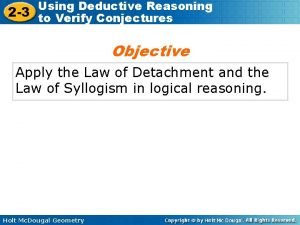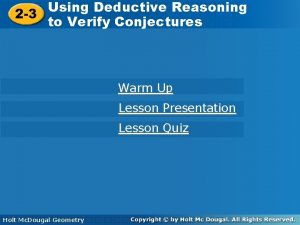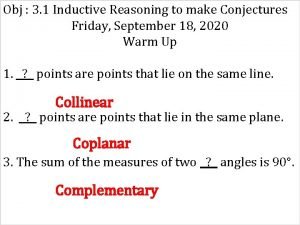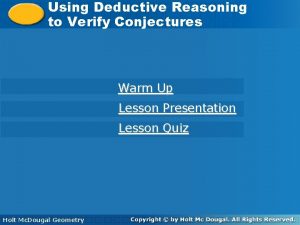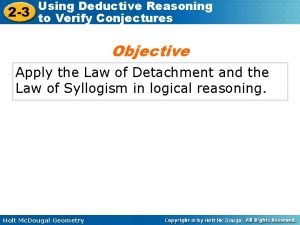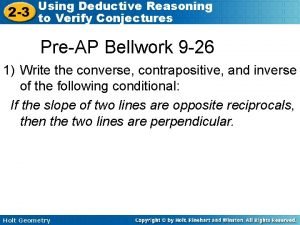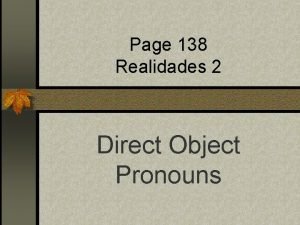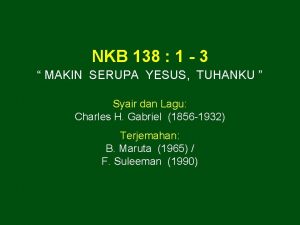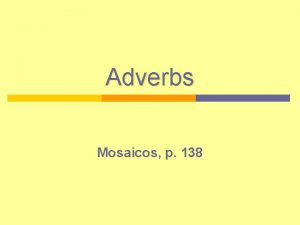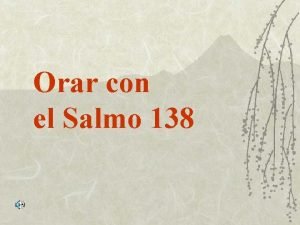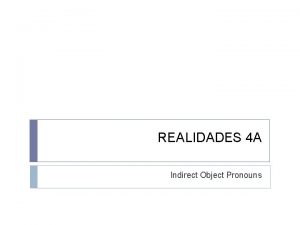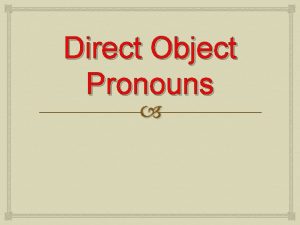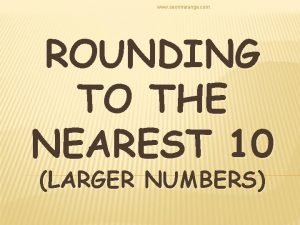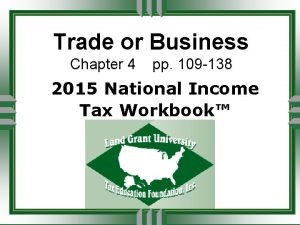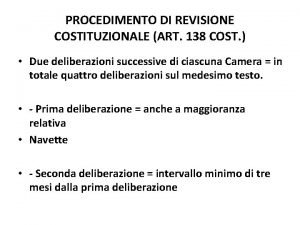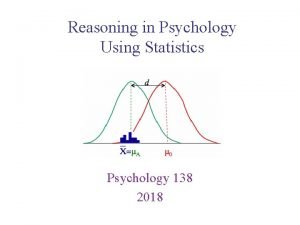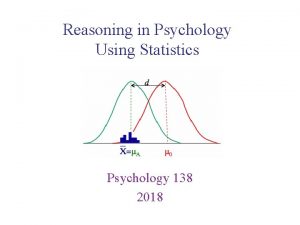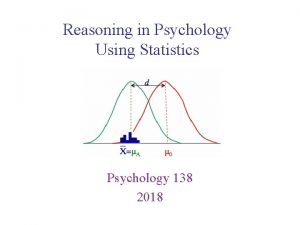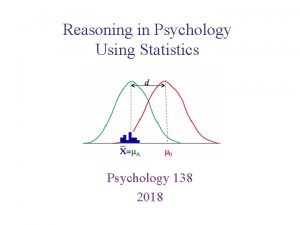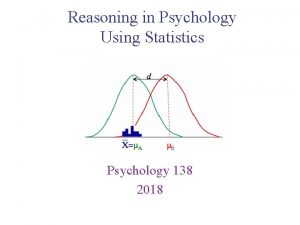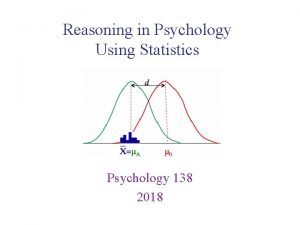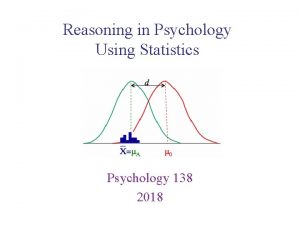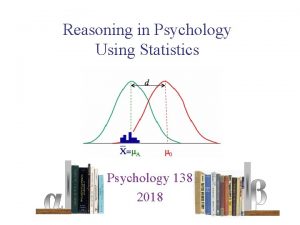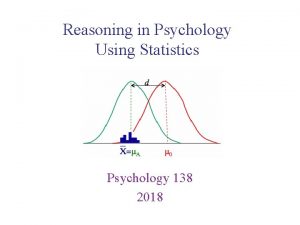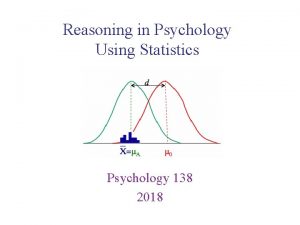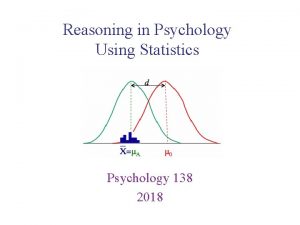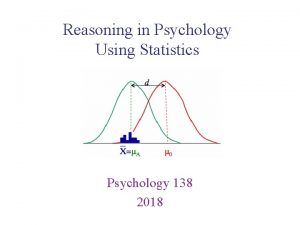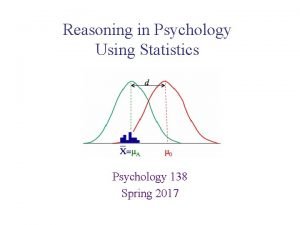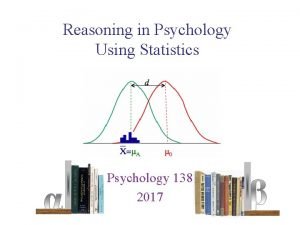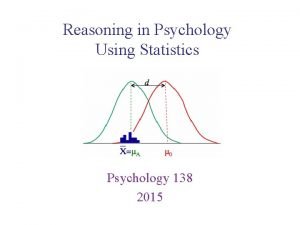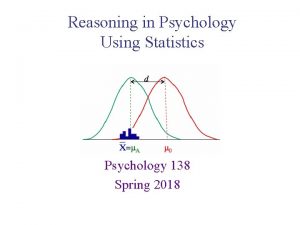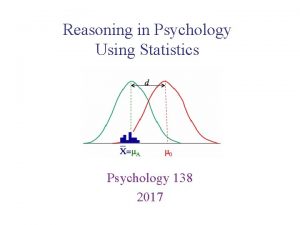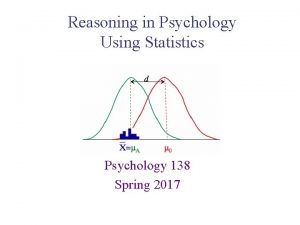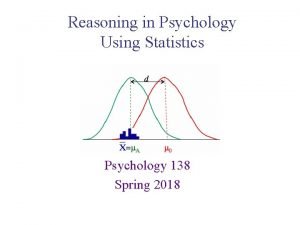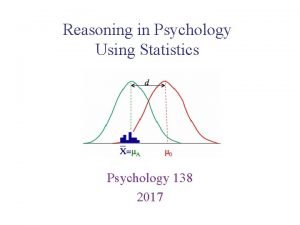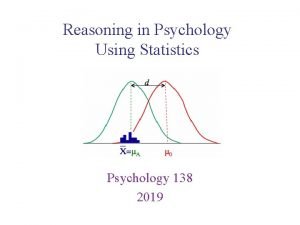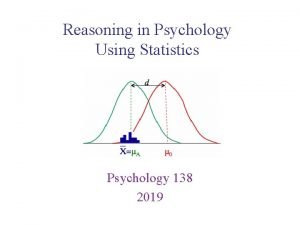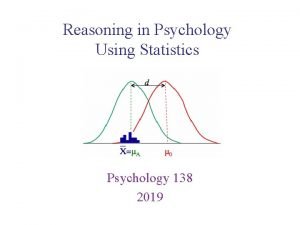Reasoning in Psychology Using Statistics Psychology 138 2018







































- Slides: 39

Reasoning in Psychology Using Statistics Psychology 138 2018

• Let’s collect set of data • I’ll pass out some pairs of dice • Collect n=36 data points – 12 people roll a pair of dice three times Rolling the dice Reasoning in Psychology Using Statistics

• Distribution – The distribution of a variable is a summary of all the different values of a variable Type numbers here: • The set of all of the outcomes of rolling the dice • Both type (each value) and token (each instance) – Un-organized, the overall pattern and properties of the distribution are difficult to see • A “picture” of the distribution is usually helpful (Data Visualization) Distributions Reasoning in Psychology Using Statistics David Mc. Candless: The beauty of data visualization

• Descriptive statistics – Statistical tools/procedures to help organize, summarize, and simplify large sets of data (distributions) – Important descriptive properties of distribution • Center – Where most of the data in the distribution are • Spread (variability) – How similar/dissimilar are the scores in the distribution? • Shape – Symmetric vs. asymmetric (skew) – Unimodal vs. multimodal Describing Distributions Reasoning in Psychology Using Statistics

Today’s focus Describing Distributions Reasoning in Psychology Using Statistics

• A “picture” of the distribution is usually helpful – Gives a good sense of the properties of the distribution • Many different ways to display distribution – Table • Frequency distribution table • Stem and leaf plot – Graphs Describing Distributions Reasoning in Psychology Using Statistics 538 Data Visualizations

• A “picture” of the distribution is usually helpful – Gives a good sense of the properties of the distribution • Many different ways to display distribution – Table • Frequency distribution table • Stem and leaf plot – Graphs Describing Distributions Reasoning in Psychology Using Statistics

The values of the variable The proportion of tokens at each value p = f/N The percentage of tokens at each value Cumulative percentage The number of tokens of each variable N=total Frequency distribution table Reasoning in Psychology Using Statistics

Quiz: “What % got this score or worse? ” 10 10% got a 1 or worse Cumulative percent Reasoning in Psychology Using Statistics

Quiz: “What % got this score or worse? ” 25 10 15% got a 2 & 10% got a 1 25% got a 2 or worse Cumulative percent Reasoning in Psychology Using Statistics

Quiz: “What % got this score or worse? ” 35 25 10 10% got a 3 & 15% got a 2 & 10% got a 1 35% got a 3 or worse Cumulative percent Reasoning in Psychology Using Statistics

Quiz: “What % got this score or worse? ” 70 35 25 10 35% got a 4 & 10% got a 3 & 15% got a 2 & 10% got a 1 70% got a 4 or worse Cumulative percent Reasoning in Psychology Using Statistics

Quiz: “What % got this score or worse? ” 90 70 35 25 10 20% got a 5 & 35% got a 4 & 10% got a 3 & 15% got a 2 & 10% got a 1 90% got a 5 or worse Cumulative percent Reasoning in Psychology Using Statistics

Quiz: “What % got this score or worse? ” 100 90 70 35 25 10 10% got a 6 & 20% got a 5 & 35% got a 4 & 10% got a 3 & 15% got a 2 & 10% got a 1 100% got a 6 or worse Cumulative percent Reasoning in Psychology Using Statistics

Fill in numbers from our class: Sample distribution n = 36 Frequency distribution: sum of 2 dice Reasoning in Psychology Using Statistics

D 1 D 2 Value D 1+D 2 frequency 12 1 11 11 2 10 10 3 10 9 9 9 4 7 Value D 1 D 2 D 1+D 2 frequency 4 6 7 7 4 4 3 3 3 2 2 1 6 6 5 6 8 8 8 7 7 7 6 6 9 8 8 Value D 1 D 2 D 1+D 2 frequency 5 5 4 5 Total outcomes = 62 = 36 = 1+2+3+4+5+6+5+4+3+2+1 = 36 Reasoning in Psychology Using Statistics Theoretical Frequency distribution: sum of 2 dice

p = probability when predicting p = proportion when describing what you observed Think of this as defining our population distribution of the outcome of tossing two dice Total outcomes = 62 = 36 = 1+2+3+4+5+6+5+4+3+2+1 = 36 Reasoning in Psychology Using Statistics Theoretical Frequency distribution: sum of 2 dice

population sample Sampling error Theoretical frequency distribution & class sample (“Actual fs” are from a previous term. ) Reasoning in Psychology Using Statistics

• Important properties of distribution – Center • Where most of the data in the distribution are – Spread (variability) • How similar/dissimilar are the scores in the distribution? – Shape • Symmetric vs. asymmetric (skew) • Unimodal vs. multimodal Distributions Reasoning in Psychology Using Statistics

What is the most frequent score? 7 Describing the distribution Reasoning in Psychology Using Statistics

What is the most frequent score? Where do most of the scores lie? Two-thirds of the data are here Describing the distribution Reasoning in Psychology Using Statistics

What is the most frequent score? Where do most of the scores lie? What was the range of scores? Maximum score: 12 Minimum score: 2 Describing the distribution Reasoning in Psychology Using Statistics

• A “picture” of the distribution is usually helpful – Gives a good sense of the properties of the distribution • Many different ways to display distribution – Table • Frequency distribution table • Stem and leaf plot – Graphs Distributions Reasoning in Psychology Using Statistics

• Distribution of exam scores (section 01): – 67, 90, 92, 58, 76, 75, 84, 92, 78, 93, 89, 74, 62, 98, 75, 73, 75, 89, 76, 65, 49 Stem and Leaf Plots Reasoning in Psychology Using Statistics 10 9 8 7 6 5 4 02238 4999 6 5 8 4 5 35 6 725 8 9

• Distribution of exam scores (section 01): 0 10 – 67, 90, 92, 58, 76, 75, 84, 92, 530 9 02238 78, 93, 89, 74, 62, 98, 75, 943 8 4999 73, 75, 89, 76, 65, 49 5 4 3 3 2 21 1 0 7 3 4 5 5 5 6 6 8 • Distribution of exam scores 6 55 2 2 6 2 57 (section 03): 8 5 8 – 72, 90, 83, 58, 66, 65, 84, 95, 2 4 9 72, 93, 89, 70, 42, 100, 71, 73, 75, 62, 74, 65 Stem and Leaf Plots Reasoning in Psychology Using Statistics

• A “picture” of the distribution is usually helpful – Gives a good sense of the properties of the distribution • Many different ways to display distribution – Table • Frequency distribution table • Stem and leaf plot – Graphs • Graphs types – Continuous variable: » histogram, line graph (frequency polygons) – Categorical (discrete) variable: » pie chart, bar chart Distributions Reasoning in Psychology Using Statistics

• Histogram • Line graph Graphs for continuous variables Reasoning in Psychology Using Statistics

• Bar chart • Pie chart Graphs for categorical variables Reasoning in Psychology Using Statistics

• Important properties of distribution – Center • Where most of the data in the distribution are – Spread (variability) • How similar/dissimilar are the scores in the distribution? – Shape • Symmetric vs. asymmetric (skew) • Unimodal vs. multimodal Distributions Reasoning in Psychology Using Statistics

• Important properties of distribution – Center • Where most of the data in the distribution are – Spread (variability) • How similar/dissimilar are the scores in the distribution? – Shape • Symmetric vs. asymmetric (skew) • Unimodal vs. multimodal Distributions Reasoning in Psychology Using Statistics

• Symmetric • Asymmetric Positive Skew tail Shape Reasoning in Psychology Using Statistics Negative Skew tail

• Unimodal (one mode) • Multimodal – Bimodal examples Shape Reasoning in Psychology Using Statistics Minor mode Major mode

• Coming up in future lectures: – In addition to pictures of the distribution, numerical summaries are also presented. – Numeric Descriptive Statistics • Shape – Skew (symmetry) & Kurtosis (shape) – Number of modes • Measures of Center • Measures of Variability (Spread) • In lab, create basic tables and graphs both by hand using SPSS – If time in lecture there are some SPSS show and tell slides • • Kahn academy: Thinking about shapes of distributions (~5 mins) Maths Tutorial: Describing Statistical Distributions (~12 mins) Kahn academy: How to create a histogram (~7 mins) Constructing a Frequency Distribution Table (~5 mins) Descriptive statistics Reasoning in Psychology Using Statistics

Drag & drop SPSS: Bar graph Reasoning in Psychology Using Statistics

SPSS: Bar graph Reasoning in Psychology Using Statistics

Drag & drop SPSS: Cluster bar graph Reasoning in Psychology Using Statistics

Legend SPSS: Cluster bar graph Reasoning in Psychology Using Statistics

Drag & drop SPSS: Histogram Reasoning in Psychology Using Statistics

SPSS Graphing Reasoning in Psychology Using Statistics
 Inductive reasoning
Inductive reasoning Inductive reasoning vs deductive reasoning
Inductive reasoning vs deductive reasoning Inductive vs deductive reasoing
Inductive vs deductive reasoing What is deductive reasoning
What is deductive reasoning Deductive method
Deductive method Inductive reasoning is reasoning based on patterns
Inductive reasoning is reasoning based on patterns Concept of logical reasoning
Concept of logical reasoning Key stage 1 reasoning paper 2018
Key stage 1 reasoning paper 2018 Que letra continua m v t m j
Que letra continua m v t m j Hashtags twitter statistics
Hashtags twitter statistics Global exhibition industry statistics 2018
Global exhibition industry statistics 2018 Introduction to statistics what is statistics
Introduction to statistics what is statistics Deductive
Deductive Using inductive reasoning to make conjectures answers
Using inductive reasoning to make conjectures answers 2-3 using deductive reasoning to verify conjectures
2-3 using deductive reasoning to verify conjectures Inductive reasoning examples
Inductive reasoning examples Using deductive reasoning to verify conjectures
Using deductive reasoning to verify conjectures Using inductive reasoning to make conjectures
Using inductive reasoning to make conjectures Using deductive reasoning to verify conjectures
Using deductive reasoning to verify conjectures Using deductive reasoning to verify conjectures
Using deductive reasoning to verify conjectures 2-3 using deductive reasoning to verify conjectures
2-3 using deductive reasoning to verify conjectures Salmo 138 5
Salmo 138 5 Realidades 2 page 138
Realidades 2 page 138 Makin serupa yesus tuhanku
Makin serupa yesus tuhanku Hsm 115 uitm
Hsm 115 uitm Double.object pronouns spanish
Double.object pronouns spanish Adverb vs adjective examples
Adverb vs adjective examples Aci 138
Aci 138 Psalm 138:1-3
Psalm 138:1-3 Tiempo de orar salmo 138
Tiempo de orar salmo 138 Tec-138-702
Tec-138-702 Pg 138
Pg 138 Indirect object pronouns p 199
Indirect object pronouns p 199 What is a direct object in spanish
What is a direct object in spanish 493 rounded to the nearest ten
493 rounded to the nearest ten 109+138
109+138 Ps 138
Ps 138 How to compute for impairment loss
How to compute for impairment loss Ephesians 4 nasb
Ephesians 4 nasb Art 138 cost
Art 138 cost












